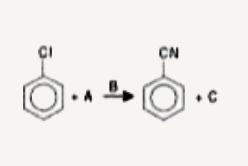Identify the weak electrolyte from the following :
Sodium chloride solution
Dilute hydrochloric acid
Dilute sulphuric acid
Aqueous acetic acid
The correct Answer is:D
To identify the weak electrolyte from the given options, we need to understand the definitions and characteristics of weak and strong electrolytes.
1. Define Electrolytes:
- Electrolytes are substances that dissociate into ions when dissolved in water. They can be categorized into two types: strong electrolytes and weak electrolytes.
2. Understand Strong Electrolytes:
- Strong electrolytes completely dissociate into ions in an aqueous solution. This means that 100% of the substance breaks down into its constituent ions. Common examples include strong acids (like hydrochloric acid, sulfuric acid) and salts (like sodium chloride).
3. Understand Weak Electrolytes:
- Weak electrolytes only partially dissociate into ions in an aqueous solution. This means that not all of the substance breaks down into ions. An example of a weak electrolyte is acetic acid (also known as ethanoic acid).
4. Analyze the Given Options:
- From the options provided, we need to identify which one is a weak electrolyte. The strong electrolytes mentioned in the transcript include hydrochloric acid (HCl), sulfuric acid (H2SO4), and sodium chloride (NaCl).
5. Identify the Weak Electrolyte:
- The only option that is a weak electrolyte among the choices is acetic acid (CH3COOH). It does not fully dissociate in solution, making it the correct answer.
Conclusion:
The weak electrolyte from the given options is acetic acid (CH3COOH).
---
- Electrolytes are substances that dissociate into ions when dissolved in water. They can be categorized into two types: strong electrolytes and weak electrolytes.
- Strong electrolytes completely dissociate into ions in an aqueous solution. This means that 100% of the substance breaks down into its constituent ions. Common examples include strong acids (like hydrochloric acid, sulfuric acid) and salts (like sodium chloride).
- Weak electrolytes only partially dissociate into ions in an aqueous solution. This means that not all of the substance breaks down into ions. An example of a weak electrolyte is acetic acid (also known as ethanoic acid).
- From the options provided, we need to identify which one is a weak electrolyte. The strong electrolytes mentioned in the transcript include hydrochloric acid (HCl), sulfuric acid (H2SO4), and sodium chloride (NaCl).
- The only option that is a weak electrolyte among the choices is acetic acid (CH3COOH). It does not fully dissociate in solution, making it the correct answer.
The weak electrolyte from the given options is acetic acid (CH3COOH).
Topper's Solved these Questions
- ELECTROLYSISBook:ICSEChapter:ELECTROLYSISExercise:Reason Based Questions
Explore 6 Videos
- ELECTROLYSISBook:ICSEChapter:ELECTROLYSISExercise:Figure Based Questions
Explore 8 Videos
- ELECTROLYSISBook:ICSEChapter:ELECTROLYSISExercise:Fill in the Blanks
Explore 22 Videos
- CHEMISTRY-2015Book:ICSEChapter:CHEMISTRY-2015Exercise:SECTION-II (40 Marks) Attempt any four questions from this Section.
Explore 49 Videos
- METALLURGYBook:ICSEChapter:METALLURGYExercise:UNIT TEST PAPER 6 - Metallurgy (Select the correct answer from the list A,B,C & given in each statement.)
Explore 5 Videos
Similar Questions
Knowledge Check
Identify the false statement from the following
AWork-energy theorem is not independent of Newton's second lawBWork-energy theorem holds in all inertial frames.CWork done by friction over a closed path is zero.DWork done is a scalar quantity
Identify the wrong statement from the following
View SolutionSort out strong , electrolytes , weak electrolytes and non-electrolytes fromt the following : KOH,Ca(OH)2NH4Cl, Urea CH3COONa,HCN,CH3COOH, Glucose.
View SolutionIdentify the wrong statements from the following:
View SolutionIdentify the correct statement from the following
View SolutionIdentify the correct statement from the following:
View SolutionIdentify the correct statement from the following
View SolutionIdentify from the following.

View Solution
